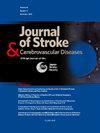急性缺血性脑卒中患者的红细胞分布宽度与预后
IF 2
4区 医学
Q3 NEUROSCIENCES
Journal of Stroke & Cerebrovascular Diseases
Pub Date : 2024-10-12
DOI:10.1016/j.jstrokecerebrovasdis.2024.108069
引用次数: 0
摘要
导言:一些生物标志物已被证实对急性缺血性卒中(AIS)患者具有预后价值。红细胞分布宽度(RDW)与多种疾病和全因死亡率相关,被认为是缺血性卒中严重程度和预后的独立预测指标。本研究旨在调查红细胞分布宽度作为缺血性脑卒中后 3 个月内功能预后和死亡的独立预测指标的情况。方法根据入院时红细胞分布宽度值的四分位数将缺血性脑卒中患者分为四组。根据情况采用Chi-square检验或Kruskal-Wallis检验比较各RDW四分位数患者的基线特征。我们对患者在事件发生后 3 个月内的功能结果进行了前瞻性分析。我们比较了 4 组患者的功能预后(根据修正的 Rankin 量表评分,分为独立型 [0-2] 和依赖型 [>2])和 90 天死亡率。为了进行这项评估,我们对 3 个月时的功能独立性和死亡率进行了单变量和多变量二元逻辑回归分析,并考虑了之前确定为潜在混杂因素的变量。RDW 四分位数越高的患者年龄越大(p<0.001),血红蛋白越低(p<0.001),C 反应蛋白水平越高(p=0.017),BNP 值越高(p<0.001),心房颤动(p=0.015)和心力衰竭(p=0.004)的发生率越高。单变量分析显示,RDW-Q4与3个月时的独立性之间存在负相关(p=0.024),但在多变量分析中并未得到验证(p=0.871)。单变量分析还发现 RDW-Q4 与 90 天死亡率呈正相关(p=0.049),但在多变量分析中未得到证实(p=0.289)。本文章由计算机程序翻译,如有差异,请以英文原文为准。
Red cell distribution width and outcome in acute ischemic stroke patients
Introduction
Several biomarkers have proven prognostic value for acute ischemic stroke (AIS) patients. Red cell distribution width (RDW) has been associated with several diseases and all-cause mortality and suggested as an independent predictor of Ischemic Stroke severity and outcome. This study aimed to investigate RDW as an independent predictor of functional outcome and death in the 3 months following AIS.
Methods
Patients with AIS were divided in four groups according to the quartile of the RDW value at admission. Baseline characteristics of patients in each RDW quartile were compared by Chi-square or Kruskal-Wallis tests, as applicable. We prospectively analyzed the patients for functional outcome in the 3 months following the event. Functional outcome (dichotomized as independent [0-2] or dependent [>2] according to the modified Rankin Scale score) and 90-day mortality was compared between the 4 groups. To conduct this evaluation, univariable and multivariable binary logistic regression analysis for functional independence and mortality at 3 months was conducted, considering the variables previously identified as potential confounders.
Results
The study's final population was of 416 patients. The patients in higher RDW quartiles were older (p<0.001), had lower blood hemoglobin (p<0.001), higher C reactive protein levels (p=0.017), higher BNP values (p<0.001) and more frequently suffered from atrial fibrillation (p=0.015) and heart failure (p=0.004). Univariate analysis showed a negative association between RDW-Q4 and independence at 3 months (p=0.024), which wasn't verified in the multivariate analysis (p=0.871). Univariate analysis also identified a positive association between RDW-Q4 and 90-day mortality (p=0.049), which was not confirmed in the multivariate analysis (p=0.289).
Conclusions
When adjusted to potential confounders, RDW does not predict functional outcome or death in the 90 days after acute ischemic stroke.
求助全文
通过发布文献求助,成功后即可免费获取论文全文。
去求助
来源期刊

Journal of Stroke & Cerebrovascular Diseases
Medicine-Surgery
CiteScore
5.00
自引率
4.00%
发文量
583
审稿时长
62 days
期刊介绍:
The Journal of Stroke & Cerebrovascular Diseases publishes original papers on basic and clinical science related to the fields of stroke and cerebrovascular diseases. The Journal also features review articles, controversies, methods and technical notes, selected case reports and other original articles of special nature. Its editorial mission is to focus on prevention and repair of cerebrovascular disease. Clinical papers emphasize medical and surgical aspects of stroke, clinical trials and design, epidemiology, stroke care delivery systems and outcomes, imaging sciences and rehabilitation of stroke. The Journal will be of special interest to specialists involved in caring for patients with cerebrovascular disease, including neurologists, neurosurgeons and cardiologists.
 求助内容:
求助内容: 应助结果提醒方式:
应助结果提醒方式:


